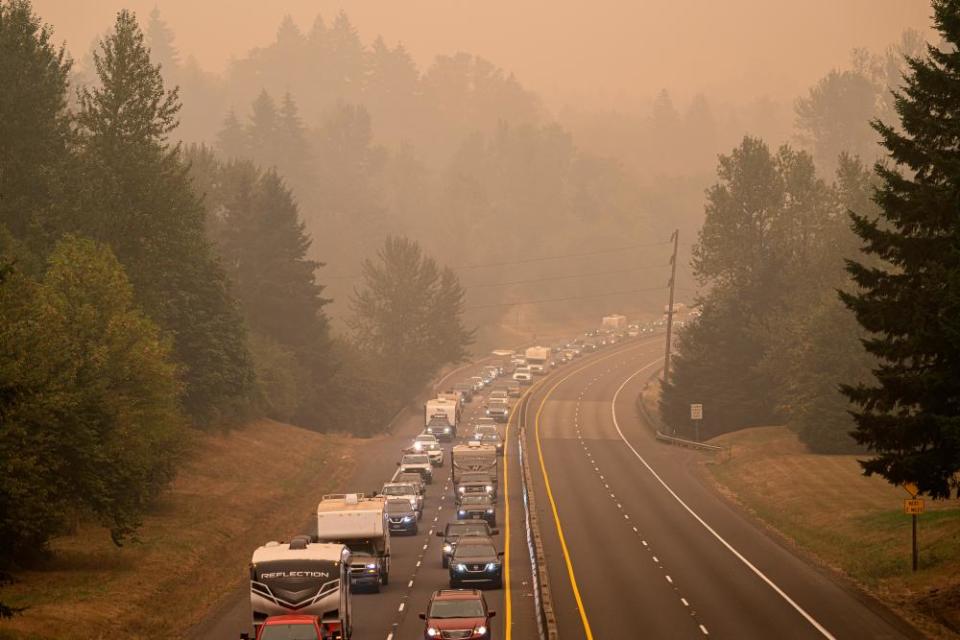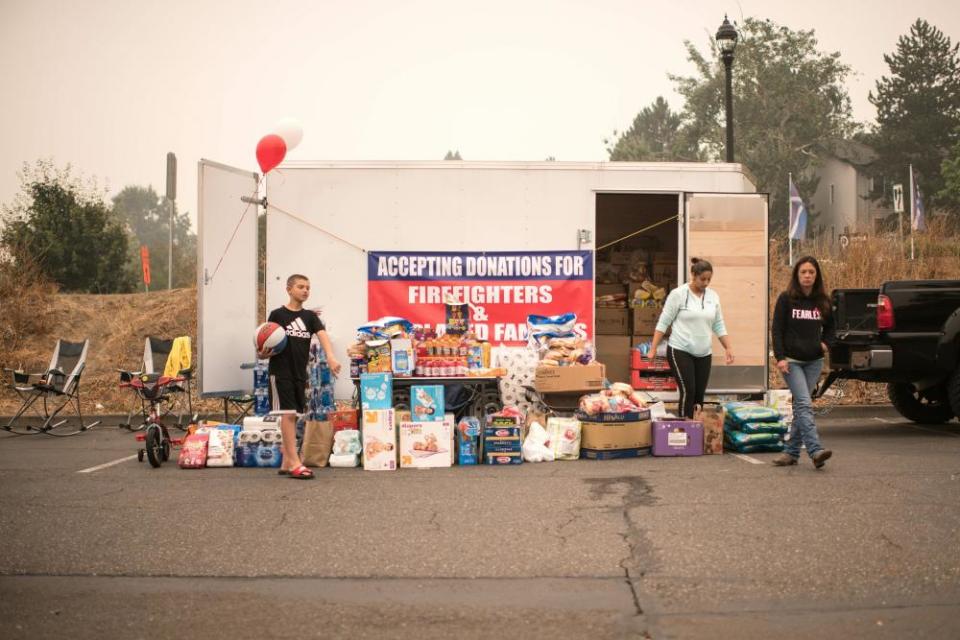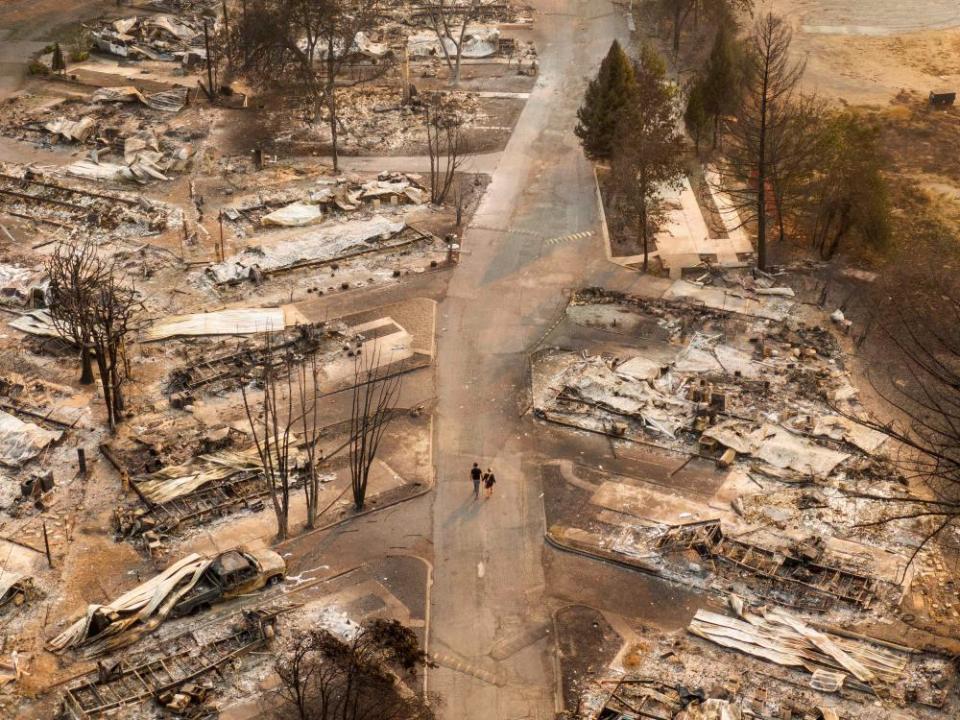Heat, wind and a cruel twist of nature: inside Oregon's nightmarish wildfire season
Kiera Erwin could see the flames. The blaze raging through the Mt Hood national forest had turned the sky orange, the air thick with smoke. It was just after Labor Day and Erwin and her boyfriend, Matthew Britt, had been packing for days, aware that evacuation neared. Now it was here. Preparation made it no less scary.
They had a new baby, Aurora, not yet two months old. No one makes face masks for babies – nothing to protect Aurora from the smoke, or the Covid-19 pandemic they would risk when they fled for town.
All this was new. In years past, wildfires had grazed but not touched their lives. Though they lived on the forest’s edge, dense wilderness to their east, they were only 20 miles from the state’s biggest city, space between woodland and the urban centers that had long been considered safe. Fires had been a feature of this region, yes – but such fires typically burned in the backcountry, unseen. Now that was changing, for Erwin’s family and for millions of other Oregonians.
Related: ‘We just had to get home’: the Californians who rebuild despite the danger of wildfires
As Erwin watched the fire creep closer, unprecedented burning was scorching much of the west. In California, a freak lightning storm had set off hundreds of blazes in mid-August. They had merged into massive complex fires that threatened lives and record swathes of land. In Washington state, fires had burned more than 700,000 acres and caused the death of a one-year-old. Colorado wildfires were setting records that would soon become worse.
And in Oregon, the 2020 fire season was already making history. Since Labor Day, 17 major fires had been raging in the state. Hot, dry conditions fueled by the climate crisis and a rare windstorm that blew fire uncontained were making them into the most destructive natural disaster in the state’s modern history.
People had warned of such a scenario all year: that wildfire could combine with the pandemic to foster unprecedented chaos. Now, that nightmare scenario was here. Hundreds of thousands of people were preparing to leave home.

Erwin, like many others, had a vague idea of where to go but no notion of when she would return and what would happen in between. Scarier still: a baby in tow, a pandemic.
What was about to unfold would test resources to unprecedented extremes, all while smoke poisoned the air for miles around. Nine Oregonians would die, nearly 1m acres would burn, 4,500 buildings, too. Several woodland towns and two suburbs would suffer the brunt of it.
All of it would leave families like Erwin’s vulnerable to flame, to virus, and to the monstrous cloud of smoke that was overtaking Oregon. Having had the time to pack was beside the point.
•••
Up until the Labor Day weekend, the fire season in Oregon had run its normal course. California was battling fierce blazes and earlier in the year than it normally would, but further north only a few fires still smoldered, small ones that consumed the bramble of the forest floor and the unmanaged thick that years of fire suppression had wrought.
Chris Cline, a district forester for the Oregon department of forestry, had come home for the holiday. In Oregon’s militia firefighting system, in which workers are called from other jobs when wildfires flare, Cline was an incident commander in the summers. The family joke was that he would kiss his wife in May and see her again in the fall.
But with little fire to fight at the start of September, Cline was at home with his wife and children. He’d just put away his work phone when it rang.
On the other end of the line was a firefighter in the field. A fire that looked like a problem, the man said. Cline heard something in his voice that sounded like alarm. He stepped outside, noticed the trees blowing and the branches shaking, a wind that was unusually fierce. Something else: it was blowing in the opposite direction it normally would. Cline said goodbye to his family, warned it could be a long night, and raced back to the office.
As more firefighters called in visuals from the ground, Cline did some quick math – the kind that people familiar with the signposts of a backcountry can do. “I think it’s 20,000 acres,” he told a colleague.
What was happening was a cruel twist of nature. The weekend had started off hot and dry – hotter than 100 degrees for three days in a row – and Cline’s region was already 20in short on rainfall. Then a cold front had pressed in from the north, bringing with it erratic winds that had turned easterly. The winds were fueling the fires still smoldering, picking up funnels of ember and laying them over, as if a great god leaned in and exhaled.
Soon after, Cline saw it for himself. By then, he was in the Willamette national forest just east of Eugene, and wind was whipping the flames of the Holiday Farm fire. Far above the ground, it snapped the tops off of trees – a sign that it was gusting, in places, up to 80mph. In a decades-long career in firefighting, Cline had only ever seen such wind in Florida, where hurricanes and fire sometimes mix. The wind was pushing flame fast through canyons.
The fire leapt ahead of itself, spotting new blazes up to a mile away. Cline’s team quickly realized there was no fighting it. Their only choice was to get people out of the way. They summoned local firefighters, police and sheriff’s deputies and swept through the forested canyon along the McKenzie River, racing down driveways, knocking on doors, leaping downed trees to urge people to leave. Residents got the message and ran. Houses burned, 365 of them. But the fire claimed just one life.
As evacuees fled, firefighters drove bulldozers back toward the flame, eventually finding anchor to prevent it from turning when the wind regained its normal course. It was hard work. In the first nine hours, the fire had traveled 16 miles. After days of effort for crews to get a line around it, it was 270 miles around. In this way, the fire season had turned from what looked like a manageable end to a kind of beginning. Seventeen significant fires – five of them larger than 100,000 acres – were burning statewide.
The Lionshead fire in Central Oregon. The Archie Creek fire to its south. The Slater fire, too, along the southern border. Similar scenes would repeat all over Oregon. Worsened by a nearby arson, the Almeda fire in Phoenix burned house to house through two suburbs, destroying hundreds of homes.
Fire burned from the north end of the state to the south along the spine of the Cascade Range. By the end of the holiday week, 40,000 Oregonians had been forced to evacuate. Half a million more were warned they might have to.
•••
It was the Riverside fire that was headed for Erwin’s home. Evacuating with a baby was a terror. She worried the stress would affect Aurora. And that the smoke could have disastrous impacts on her health.
She and Britt headed to Estacada first, a small rural town about six miles from where they rented land. They waited till morning to go back for their car and a motorhome that served as a workshop for Britt, a diesel mechanic. Erwin drove it from the thick woods on to a three-lane highway, towing the car. It was her first tour behind the wheel of a motorhome. It did not go smoothly.
They eventually made it to the Clackamas Town Center, a retail mall another 20 miles away that topped the list of places evacuees could run with large vehicles. It was a typical mall, a place of shiny floors and escalators anchored by a JC Penney. By then, 23-acres of the parking lot had been cordoned off. A village was growing on the blacktop, made up of evacuees and campers, tents and RVs, everyone ready to hurry up and wait.
The air had worsened, thick with the smoke and ash of forests the evacuees had fled. It blocked out the sun. The world was a fog of it. And all Erwin could do for Aurora was hunker indoors and try to keep the smoke outside.
As she huddled in her home with her baby – Britt sometimes outside, tending to the motorhome – a new community formed outside. Overnight, dozens of volunteers had started parsing through donations that came flooding toward evacuees, assuming a mounting task of logistics.

Helming the effort were Portland’s Neighborhood Emergency Teams, colloquially known as NETs, a city-wide brigade of more than 2,100 active members, trained to assist in earthquakes. They had responded to texts, calls and emails, proving themselves game for whatever disaster called. In that, they underscored the depth of resilience that communities prepared for such emergencies can build. And must.
Evacuees had arrived at the Town Center with chickens and rabbits, parrots even. Some people were sleeping in cars. One woman, who brought her cat, had simply run with it to the car and was desperately in search of a litter box. A family that left – eight of them, three generations – without tents or blankets but carrying everything with a beating heart, was in search of anything other than Tupperware in which to house their rats. Some set chickens grazing on what used to be the parking strips.
Volunteers sorted aid from what donations rained. There were pallets of food – water, granola bars, dry cereal, diapers – the standard fare of disaster relief. Then there were some not-so-standard gifts: a truckload of corn, meals that people had cooked, sandwiches delivered on paper plates. They wondered what to do with the shower unit that showed up late one night, who had ordered it, and whether it had power or anyone knew how to work it. Or how to manage the charging station that AT&T brought, connected as it was to electricity somewhere farther flung toward the mall, where life continued as normal.
By day, the lot was mobbed with such helpers. They kept their distance – Covid, of course – but served food, brought ice. Maybe 50 people a day, Erwin said, “offering all this help, more than we needed”.

Parents were worried about some of the people who came to the encampment at night or for food and donations, and kept their teens and children close after dark. But what seemed scary at first was quickly less so. “It was pretty awesome how everybody helped everyone out like that. It was not what I expected,” Erwin said.
Wynter Lewis had leapt out of her bed to deliver blankets after a late-night Facebook scroll and ended up staying for roughly a week. She came to Erwin’s door. Asked if she needed anything, asked about the baby. “She was just really, really sweet to me,” Erwin said. “I had my boyfriend to talk to, but I didn’t have anybody to connect with me the way she did.”
Lewis found gas, diapers, toys for Erwin’s dogs and dog beds. Elsewhere, she found a litterbox for the cat, flashlights for kids in tents, pile of blankets. And she dogged the Red Cross for hotel vouchers for a family packed into a car trailer, two members of which were dialysis patients.
All the while, the smoke level climbed, soon topping what the government’s air quality index could even measure. For most people there was no getting out of it. One man who was in a tent, “You would see him walking around, and you could actually just see his chest going in and in and in,” Lewis said.
•••
Fire has always been part of Oregon’s landscape, a hallmark of September in a state in which half of 61m acres are forested. But several of Oregon’s worst fires are known to have been propelled by rare, easterly winds: Silverton, 1865; the Tillamook Burn, 1933. Fires that remade the landscape, defined the narrative of towns and delineated a line in a before and after of communities. The Labor Day fires of 2020 now join their ranks.
The climate crisis has contributed. Some people in Oregon don’t like to talk about it – like the rest of America the state is increasingly divided along partisan lines. But the symptoms of climate breakdown are widely agreed upon fact. The forests are drier. The weather is hotter. The fire seasons have also grown longer.
Since 1970, the fire season has lengthened from five months to more than seven. Although the number of fires has remained about the same, the acreage burned each year is growing dramatically – from five digits to six over the last decade, including a pinnacle 517,883 acres in 2017, to roughly 1m acres this year.
Bark beetles, which thrive among drought stricken trees, have wrecked havoc in Oregon’s forest – dropping dead trees on the floor like accelerants. The longstanding practice of suppressing fires had also complicated matters. Fires is nature’s way of keeping house, burning through dead brush and bramble on the forest floor. When dead wood piles up, it acts like a ladder, helping flames to reach the canopy, where fire can get up and run. Forest management can help in a normal fire year. But the trouble is that no one knows what normal is any more.
Unprecedented as they were, the Labor Day fires posed enormous challenges to first responders. Operations forces converged at the national guard readiness center in Salem, the state capitol, with workers from the federal emergency management agency (Fema), various forest agencies, firefighters and government scrambling for a foothold.

Morning calls convened commanders from across the state, reporting from the frontlines of the blazes now being fought by 7,500 firefighters. To minimize the risk of Covid-19 infections, firefighters social-distanced in camps and dined on prepared meals. Many didn’t go home for weeks.
The logistical challenges, alone, were massive. Who would feed the soldiers who had turned up from the national guard? What to do with another 200 polaskis? Would debris would block rivers and streams? Or burn up electrical utilities?
Just fighting the fires would cost $130m. Then there was the business of explaining them. While Oregonians heard devastating tales of lives and homes lost, armed militiamen deployed to block roads and patrol homes amid disinformation the fires had been started by antifascists and looters. Near the Riverside fire, militiamen stopped civilian drivers, turned away journalists, and mistook one documentarian as an Antifa infiltrator. There were enough death threats, innocent motorists detained, and homeowners barred from their own properties that law enforcement urged civilians to stand down and stop calling 911 with nonsense from Facebook.
Eventually, rain came. And just like they began, the Labor Day fires were turned by nature until a few dogged patches of forest still smoldered, this time encircled by crews.
•••
Cline, the forester who took command of the Holiday Farm fire, knows these fires will be talked about for generations. And that the recovery, in places, might take just as long. “It will all look different for a while. Some places will recover and look very similar. And in other places … the trees might not want to grow the same.”
Restoration now depends on what resources people will have, he said. To rebuild, to clear land, to make way for whatever comes next. It falls to many of Cline’s colleagues to corral those now, to find the seeds for replanting, the money to press ahead, and meanwhile shore up the roads and the lands now at risk for mudslides in the wet of the Oregon winter.
This was life-changing for everybody
Kiera Erwin
Officials have only begun to take stock of what needs fixing. Bridges. Culverts. Power lines. River crossings. And all the wildlands where water will now run unimpeded across charred soil. The things to worry over include fish habitat and drinking water, where to find the chainsaws, the logging trucks, the contractors to do the work. Probably it is years of work. Probably it is weeks before it’s even clear how many years of work and what kind.
“The winter weather is upon us and it’s going to be a challenge to stay in front of those concerns,” said Ryan Gordon, a wildland fire supervisor on the North Cascade district of the Oregon department of forestry, who is now deeply involved in recovery efforts. “The long days haven’t stopped yet … I know that a lot of us are definitely ready for a break and I’m not sure exactly when that will come.”
Things aren’t quite back to normal for Erwin and her family yet either. But they’re working on it. The Riverside fire spared their patch of land, though it jumped the road to burn the timber there, scarring the landscape around their home like a lot of other places. Despite that, Erwin says she feels more rooted here than before, closer to a community whose bonds deepened with calamity.
This place before, she said, “I always thought of it as just people doing their thing. We never had to go through anything like this … This was life-changing for everybody.”

